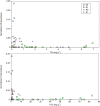Metagenomic insights into diazotrophic communities across Arctic glacier forefields
- PMID: 29901729
- PMCID: PMC6054269
- DOI: 10.1093/femsec/fiy114
Metagenomic insights into diazotrophic communities across Arctic glacier forefields
Abstract
Microbial nitrogen fixation is crucial for building labile nitrogen stocks and facilitating higher plant colonisation in oligotrophic glacier forefield soils. Here, the diazotrophic bacterial community structure across four Arctic glacier forefields was investigated using metagenomic analysis. In total, 70 soil metagenomes were used for taxonomic interpretation based on 185 nitrogenase (nif) sequences, extracted from assembled contigs. The low number of recovered genes highlights the need for deeper sequencing in some diverse samples, to uncover the complete microbial populations. A key group of forefield diazotrophs, found throughout the forefields, was identified using a nifH phylogeny, associated with nifH Cluster I and III. Sequences related most closely to groups including Alphaproteobacteria, Betaproteobacteria, Cyanobacteria and Firmicutes. Using multiple nif genes in a Last Common Ancestor analysis revealed a diverse range of diazotrophs across the forefields. Key organisms identified across the forefields included Nostoc, Geobacter, Polaromonas and Frankia. Nitrogen fixers that are symbiotic with plants were also identified, through the presence of root associated diazotrophs, which fix nitrogen in return for reduced carbon. Additional nitrogen fixers identified in forefield soils were metabolically diverse, including fermentative and sulphur cycling bacteria, halophiles and anaerobes.
Figures



Similar articles
-
The Spatial Dynamics of Diazotrophs in the Forefield of Three Tibetan Glaciers.Microb Ecol. 2024 Nov 13;87(1):138. doi: 10.1007/s00248-024-02460-6. Microb Ecol. 2024. PMID: 39532738 Free PMC article.
-
Application of a nifH microarray to assess the impact of environmental factors on free-living diazotrophs in a glacier forefield.Can J Microbiol. 2011 Feb;57(2):105-14. doi: 10.1139/w10-100. Can J Microbiol. 2011. PMID: 21326352
-
High diversity of diazotrophs in the forefield of a receding alpine glacier.Microb Ecol. 2009 Jan;57(1):179-90. doi: 10.1007/s00248-008-9408-5. Epub 2008 Jun 18. Microb Ecol. 2009. PMID: 18563478
-
Marine Non-Cyanobacterial Diazotrophs: Moving beyond Molecular Detection.Trends Microbiol. 2016 Nov;24(11):916-927. doi: 10.1016/j.tim.2016.07.002. Epub 2016 Jul 29. Trends Microbiol. 2016. PMID: 27476748 Review.
-
Nitrogen fixation and photosynthetic oxygen evolution in cyanobacteria.Res Microbiol. 2003 Apr;154(3):157-64. doi: 10.1016/S0923-2508(03)00029-9. Res Microbiol. 2003. PMID: 12706503 Review.
Cited by
-
Bacterioplankton Community Composition Along Environmental Gradients in Lakes From Byers Peninsula (Maritime Antarctica) as Determined by Next-Generation Sequencing.Front Microbiol. 2019 Apr 30;10:908. doi: 10.3389/fmicb.2019.00908. eCollection 2019. Front Microbiol. 2019. PMID: 31114558 Free PMC article.
-
Microbial diversity in Antarctic Dry Valley soils across an altitudinal gradient.Front Microbiol. 2023 Jul 24;14:1203216. doi: 10.3389/fmicb.2023.1203216. eCollection 2023. Front Microbiol. 2023. PMID: 37555066 Free PMC article.
-
The Abundance of the nifH Gene Became Higher and the nifH-Containing Diazotrophic Bacterial Communities Changed During Primary Succession in the Hailuogou Glacier Chronosequence, China.Front Microbiol. 2021 May 31;12:672656. doi: 10.3389/fmicb.2021.672656. eCollection 2021. Front Microbiol. 2021. PMID: 34135879 Free PMC article.
-
Role of Cyanobacteria in the assembly and dynamics of microbial communities on glacier surfaces.iScience. 2025 Feb 18;28(3):112061. doi: 10.1016/j.isci.2025.112061. eCollection 2025 Mar 21. iScience. 2025. PMID: 40104071 Free PMC article.
-
Ecological significance of Candidatus ARS69 and Gemmatimonadota in the Arctic glacier foreland ecosystems.Appl Microbiol Biotechnol. 2024 Dec;108(1):128. doi: 10.1007/s00253-023-12991-6. Epub 2024 Jan 15. Appl Microbiol Biotechnol. 2024. PMID: 38229335 Free PMC article.
References
-
- Allison SD, Treseder KK. Warming and drying suppress microbial activity and carbon cycling in boreal forest soils. Global Change Biol. 2008;14:2898–909.
-
- Allison VJ, Condron LM, Peltzer DA et al. Changes in enzyme activities and soil microbial community composition along carbon and nutrient gradients at the Franz Josef chronosequence, New Zealand. Soil Biol Biochem. 2007;39:1770–81.
Publication types
MeSH terms
Substances
LinkOut - more resources
Full Text Sources
Other Literature Sources

